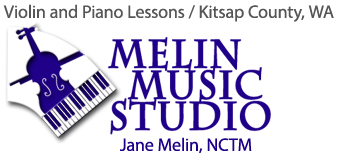As you progress into the last 4 ASTA Levels, the technical challenges advance substantially. You will need to play extended fast passages evenly and cleanly; encounter double-stop passages more often in pieces; shift fluidly and quickly into and out of high positions (V and above); master more difficult bowing skills including fast spiccato, sautille and complex string crossings. All basic foundational skills should be mastered (playing with straight bow, good hand/arm/finger technique), with ever-improving intonation and confident, constant vibrato. 12-15 months is not too long to expect to be working on completing each of these levels; it will depend greatly on how much time you spend in focused practice.
- Baroque repertoire in the advanced levels often has extended double-stop passages featuring counterpoint (2 melodies playing at once). The Bach Unaccompanied Sonatas and Partitas are core repertoire at the top 3 levels.
- The Mozart Concerto in G (#3) is the first core Classical work to be introduced at Level 8. Shorter works by Mozart such as several sonatas are available for study at this level.
- Romantic advanced repertoire often consists of show-pieces composed to spotlight the violinist’s technical skills. Sometimes the musicality of the piece can be overshadowed by the showoff factor. Be sure you choose pieces that appeal to you melodically, or have technical flair that you would like to learn to play (such as gypsy-style), or you may grow tired of working on the piece before you have mastered it.
- Selections from the Contemporary period often feature complex harmonies and dissonances. It is good to explore this music to broaden your horizons and prepare for orchestral playing or auditions; choose at least one piece between Level 7 and Level 10 in this genre.
Requirements:
One fast concerto movement (List A) and two short contrasting pieces (List B) representing three different composers and at least two different time periods. All memorized.
Pieces marked with * or ** are considered core repertoire; choose at least one piece that has a */**.
**These are Mrs. Melin’s favorites from the core repertoire.
List A: Fast Concerto Movements
Baroque Period
**Bach Concerto #2 in E (1st or 3rd mvt.)
Spohr: Concerto No. 2 in Dm, Op. 2
Tartini: Concerto in Dm
**Vivaldi: Summer, from “Four Seasons”, 1st or 3rd mvt.
Classical Period
*Haydn: Concerto No. 1 in C
Mozart: Concerto #1 in Bb (first or third movement)
**Mozart: Concerto #3 in G (first or third movement, without cadenza)
Romantic Period
De Beriot: Concerto #7 in G or **#9 in Am (SFYV Bk. 4)
Kreutzer: Concerto No. 13 in D
Rode: Violin Concerto #6 in Bb, #7 in Am or #8 in Em
List B: Shorter Pieces
Baroque Period
**Bach: Solo Sonatas & Partitas
Veracini: Sonata in A, Op. 2, No. 6
Veracini: Sonata in Em (Suzuki Bk. 8)
Classical Period
*Mozart: Rondo in C, K. 373
*Mozart: Sonatas, K.301, K.304 or K.305
Schubert: Sonatinas in Am and Gm, Op. 137
Romantic Period
*Beethoven: Romance in F
Drigo: Valse Bluette (found in “37 Pieces You Like to Play”)
Dvorak: 4 Romantic Pieces, Op. 75; play at least two.
Grieg: Sonata in F, Op. 8, No. 1
Hubay: Hejre Kati, Op. 32, No. 4
*Kreisler: Sicilienne and Rigaudon
Sarasate: Playera, Op. 23, No. 1
Smetana: Aus der Heimat
*Tschaikovsky: Canzonetta from Violin Concerto
Tschaikovsky: Melodie (in “3 Pieces, Op. 42”)
*Wieniawski: Legende, Op. 17
Wieniawski: Romance from Violin Concerto in Dm
Wieniawski: Two Mazurkas, Op. 19 (Obertass Dudiarz), choose one
Contemporary Period
De Falla: “Suite Populaire Espagnole,” Jota or two other movements
Foss: Composer’s Holiday
Gardner: From the Canebrake, Op. 5, No. 1
Ravel: Piece en Forme de Habanera
